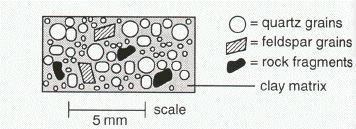Chalky Insoluble Travertine Deposits Are Precipitated by Bluegreen Bacteria
sand sized material
plant remains
clay minerals
carbonate
sand sized material
coal
shale
conglomerate
a rock formed from the cementation of transported grains
a rock formed from evaporation of sea water
transformed by heat into limestone
transformed by pressure into limestone
bedding
foliation
fossils
all may be associated with sedimentary rocks
coarse clastics
fine clastics
chemical
biochemical
lilthification
compaction
metamorphism
sorting
rivers
wind
ocean waves
all of these
alluvial
beach
desert
glacial
alluvial
continental shelf
deltaic
organic reef
silica
calcium carbonate
calcium phosphate
calcium sulfate
rivers
wind
turbidity currents
all of these
carbonate shells
silica-rich shells
fine grained material transported by the wind
all of these
alluvial
beach
deep-sea
desert
cooling and contraction of the crust
deposition of sediments
erosion of sediments
tectonic down faulting
sandstone, siltstone, conglomerate
sandstone, conglomerate, siltstone
conglomerate, sandstone, siltstone
siltstone, sandstone, conglomerate
breccias are coarse grained and conglomerates are fine grained
conglomerates are coarse grained and breccias are fine grained
breccias have rounded fragments and conglomerates have angular fragments
breccias have angular fragments and conglomerates have rounded fragments
arkose
litharenite
quartz arenite
shale
arkose
litharenite
quartz arenite
shale
halite
limestone
chert arenite
coal
cementation
compaction
sedimentation, metamorphism, diagenesis
diagenesis, sedimentation, metamorphism
sedimentation, diagenesis, metamorphism
metamorphism, diagenesis, sedimentation
compaction
cementation
lithification
metamorphism
the wind
streams
ocean waves
pocket gophers
becomes rounded
becomes smaller
becomes rounded and smaller
none of these
becomes rounded
becomes smaller
becomes rounded and smaller
none of these

1
2
3
4
natural gas
oil
limestone
preserved plant material
active margin beach
alluvial fans
glacial
deep marine
active margin beach
alluvial fans
glacial
deep marine
glacial
alluvial fans
deltaic
deep marine
in an evaporite environment
in a swamp environment
in a reef environment
in a deep-sea environment

<-------
-------->
<------->
cannot determine direction from information given.
cross beds
graded beds
point bars
ripple marks.
halite
limestone
chert
coal
on sand beneath the waves at beaches
on underwater sandbars in streams
on the surface of windswept dunes
all of these can have ripples
alluvial
beach
deep-sea
desert
0 degrees C
100 degrees C
300 degrees C
1000 degrees C
recrystallization
compaction
cementation
all may occur
recrystallization
compaction
cementation
all are physical in nature
less than 5%
between 5% and 25%
between 25% and 50%
> 50%
limestones and dolomites
sandstones and conglomerates
cherts and evaporites
mudstones and shales

quartz arenite
litharenite
arkose
this is a granite!!
quartz arenite
litharenite
arkose
shale
quartz arenite
litharenite
arkose
shale
Source: https://www.uh.edu/~jbutler/physical/chap7mult.html
0 Response to "Chalky Insoluble Travertine Deposits Are Precipitated by Bluegreen Bacteria"
Post a Comment